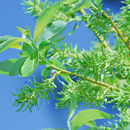More info for the term:
root collarIn northern Alberta, Bebb willow is common around sloughs in prairies,
and in foothills, upland forests, wet lowlands, thickets, and muskegs.
It is often found in thickets adjacent to streams, swamps, and lakes in
Alaska [
45]. In Idaho and Montana, Bebb willow is best represented in
riparian communities within the Douglas-fir (Pseudotsuga menziesii) zone
and sagebrush/grass habitats. It is apparently absent in the subalpine
zone but does sometimes occur in cool Engelmann spruce (Picea
engelmannii) dominated streambottoms in the upper Douglas-fir zone
[
6,
18].
Soils: Bebb willow is usually found on moist sandy or gravelly soils
but is adapted to a wide variety of soil textures [
45]. It will
tolerate moderately alkaline soils but does poorly in extremely acidic
or alkaline conditions [
21,
45]. The general pH range for willows is 5.5
to 7.5 [
17]. Bebb willow can survive short periods of standing water,
but growth rates decline sharply if water persists above the root collar
[
18,
30]. This willow is not drought tolerant, however, and prefers
sites with adequate moisture. It is also shade intolerant and grows best
in full sunlight [
45].
Elevational range: The elevational range of Bebb willow in several
states is as follows [
6,
9,
22]:
Utah: 4,400 to 8,600 feet (1,341-2,621 m)
Colorado: 5,000 to 9,600 feet (1,524-2,926 m)
Wyoming: 4,500 to 8,300 feet (1,372-2,530 m)
Montana: 2,800 to 8,500 feet (853-2,591 m)
Arizona: 8,000 to 11,000 feet (2,438-3,353 m)
Idaho: 3,300 to 7,900 feet (1,010-2,410 m)
Plant associates: Bebb willow is commonly associated with the
following species: Pacific willow (Salix lasiandra), thinleaf alder
(Alnus tenuifolia), redosier dogwood (Cornus stolonifera), dwarfed
blackberry (Rubus pubescens), black cottonwood (Populus trichocarpa),
quaking aspen (P. tremuloides), water birch (Betula occidentalis),
bluejoint reedgrass (Calamagrostis canadensis), beaked sedge (Carex
rostrata), water sedge (C. aquatilis), false-Solomons-seal (Smilacina
stellata), sweet scented bedstraw (Gallium triflorum), rush (Juncus
spp.), and bluegrass (Poa spp.) [
18,
19,
37,
45].

